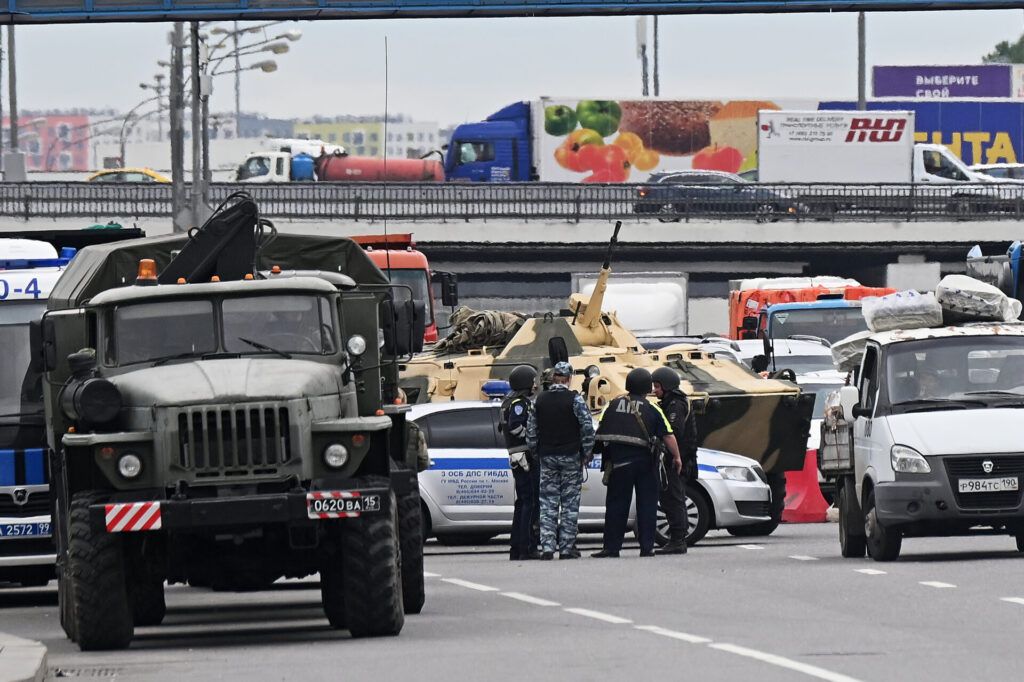Prigozhin, Putin, and the Russian coup that evaporated
By John Mecklin | June 24, 2023
 Russian police stand at a checkpoint on Saturday in Moscow, Russia. The Wagner Group, an independent army led by former Putin ally Yevgeny Prigozhin, had vowed to "go all the way" to Moscow to topple Russia's military leadership. The apparent coup attempt ended Saturday when Prigozhin called off the rebellion and agreed to leave Russia for Belarus. (Photo by Epsilon/Getty Images)
Russian police stand at a checkpoint on Saturday in Moscow, Russia. The Wagner Group, an independent army led by former Putin ally Yevgeny Prigozhin, had vowed to "go all the way" to Moscow to topple Russia's military leadership. The apparent coup attempt ended Saturday when Prigozhin called off the rebellion and agreed to leave Russia for Belarus. (Photo by Epsilon/Getty Images)
In a stunning whiplash turn of only partly explained events, Russian mercenary leader and oligarch Yevgeny Prigozhin directed his military forces to take control of a major Russian military headquarters on Friday, then had them set off on a march on Moscow—and then, after reported consultation with Belarus President Aleksandr Lukashenko, called off the rebellion on Saturday.
The shocking, short-lived insurrection began on Friday, when elements of Prigozhin’s mercenary forces, known as the Wagner Group, seized a military headquarters for southern Russia in Rostov-on-Don. Prigozhin, a frequent and vociferous critic of the Russian military leadership, contended Russian forces had attacked—and killed—some Wagner Group troops and vowed retribution. Subsequently, Wagner Group forces moved north toward Moscow, occupying at least one other city along the way.
Russian President Vladimir Putin responded by mobilizing the government’s military forces, which took to Moscow streets and areas further south. In a televised speech on Saturday, Putin called Prigozhin’s efforts a treasonous armed rebellion and promised that those responsible “will answer for this.”
Later on Saturday, however, the coup appeared to evaporate when Prigozhin announced that his troops would halt their march on Moscow to avoid bloodshed. Although details were murky, that announcement was subsequently reported to be part of a deal, negotiated with Lukashenko, in which Prigozhin agreed to leave Russia for Belarus, and the Russian government agreed to drop the criminal case it had opened against the mercenary leader.
The quick resolution of the rebellion raised obvious questions that a variety of Russia experts were quick to address, as well as they could, given the paucity of information available outside top levels of the Russian government. Pavel Podvig, director of the Russian Nuclear Forces Project, posted a Twitter string that addressed perhaps the most important of those questions:
Can an armed group like Wagner take control of some of Russia’s nuclear weapons and somehow use or detonate them? The short answer is no, it’s virtually impossible. I wanted to write a longer thread, but things are happening way too fast. 1/
— Pavel Podvig (@russianforces) June 24, 2023
Nikolai Sokov, a senior fellow at the Vienna Center for Disarmament and Non-Proliferation who previously worked at the Soviet and Russian Ministry for Foreign Affairs and participated in the START I and START II negotiations, weighed in, perhaps too self-effacingly, with “[a] few notes from someone who is not a Russia watcher,” suggesting that “a shakeup at the top of [the Russian Ministry of Defense] seems likely (army may like it, too),” even though the coup failed.
A few notes from someone who is not a Russia watcher.
(1) Prigozhin did not rebel against Putin – he never said a word against him. His blamed was squarely on top military, including for the war (misplaced, but he chose his targets carefully).
(2) Wagner was not (1/n)— Nikolai Sokov (@SokovNikolai) June 24, 2023
Many commenters on social media and television marveled at the strangeness and seeming unbelievability of the negotiated deal that would, supposedly, leave Prigozhin free in Belarus after he had engaged in what Putin—known to be a ruthless pursuer of enemies—openly termed treason. As former US ambassador to Russia Mike McFaul put it:
Just several hours ago, Putin told his entire nation that Prigozhin was a traitor. Can he just turn around now and declare bygones? Im not sure this is as easy as some are suggesting.
— Michael McFaul (@McFaul) June 24, 2023
There was also much speculation that Prigozhin’s short-lived insurrection would undermine Putin’s authority over the longer term. Given the unusual and fast-moving series of events, however, it was entirely unclear, late on Saturday, how closely the public reporting on the two-day coup matched the underlying reality, and how much of what had happened was still to be revealed.
Together, we make the world safer.
The Bulletin elevates expert voices above the noise. But as an independent nonprofit organization, our operations depend on the support of readers like you. Help us continue to deliver quality journalism that holds leaders accountable. Your support of our work at any level is important. In return, we promise our coverage will be understandable, influential, vigilant, solution-oriented, and fair-minded. Together we can make a difference.
Keywords: Prigozhin, Wagner Group, coup, insurrection, rebellion
Topics: 2020 Doomsday Clock mentions, Analysis, Nuclear Risk
















I don’t believe that Putin would let Prigozhin walk after an attempted coup. I don’t think he would have let the Wagner group go so far into Russia without jets, rockets, and helicopters taking them out. These were mainly just trucks carrying soldiers. Putin has wanted to nuke Ukraine for over a year but was afraid he would be nuked. So, he and Prigozhin planned everything that happened yesterday months ago. It was a fake coup attempt. Belarus is a Russian state. If it had been a real coup attempt Prigozhin would not go there because he would be killed instantly. That is not… Read more »
Such a well-written article! What about the issue of whether this was a subterfuge (false flag to use the current metaphor), where Pregozian gets more $ and bullets, and can lead an attack from the north, establishing two fronts? Where did the troops who accompanied him in Rostov go? Back to Ukraine? to Belorussia?
If Wagner and Prighozin wanted to relocate to Belarus to regroup for an attack, they could’ve just done that without carrying out a charade that exposes how poor defenses are within Russia and makes Putin look weak and exposed.
We don’t have all the information to know what actually transpired.
Great article. It’s scary to think such instability exists in a country that has enough nuclear weapons to lay waste in radioactive ash every major city on earth a few times over and still have plenty to spare. Another good motivation for everyone ( with no exclusions) to sign the TPNW. You never know who’s hands will end up on the nuclear button.